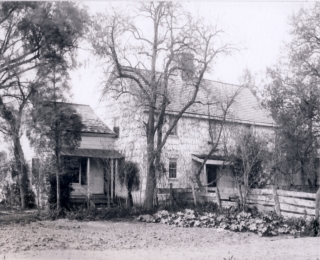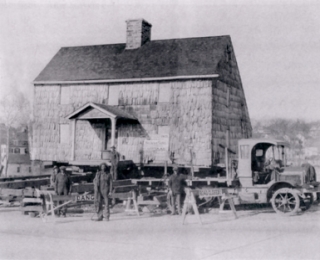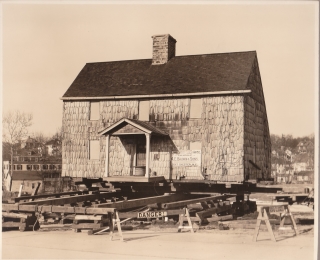The Thomas Lyon House
About The Thomas Lyon House
The first project being pursued by the Greenwich Preservation Trust is the preservation of the Thomas Lyon House located at One Byram Road in Greenwich Connecticut. The Thomas Lyon House is the oldest unaltered Colonial house in Greenwich. Probably built circa 1695, it remains relatively unchanged and retains a Colonial footprint established more that 300 year ago. Moved nearly intact in 1927 from its first site on the north side of Boston Post Road, this classic saltbox retains much of its original building material.
Gateway to New England
In 1922 the Atlantic Highway, which ran from Maine to Florida, was renamed Route 1, and changes to the 2,400-mile road began in many states. In Greenwich the road was slated to be widened in 1925, and town leaders began to look for a suitable entryway to Greenwich, and, by extension, to the rest of New England.
When Julia Lyon Saunders and her husband Chester realized her family’s home would be demolished to accommodate the new road, they accepted an offer from the Lions and Rotary clubs in 1925 to move it to the opposite side of the road, on land the Town had purchased for the new Byram School, to be used as the “Gateway to New England.”
Its location as the first house in New England on Route 1, coupled with increasing automobile tourism, seemed to make it the perfect choice for a welcome and information center for Greenwich and New England.
The clubs launched a preservation movement to raise funds to move the house and restore it to its original Colonial condition. Sponsors of their movement included 36 of Greenwich’s most prominent people: town administrators, judges, doctors, churchmen, and businessmen. The clubs hired noted Greenwich architect Theodore E. Blake, associated with Carrere & Hastings, to prepare plans for the restoration and the fund-raising campaign began.
Enough money was raised to move the house across the road in 1927 to land leased from the Town, but there was little left to restore the interior. The onset of The Great Depression in 1929 provided a poor climate in which to raise funds for historic preservation
After five years, the two clubs decided to lease the house to The American Fence Company, who would use one downstairs room as an office and restore the interior and make it available for visitors interested in Colonial homes and history. An article in the Greenwich Press on April 7, 1932, states that “the shrine is not to be commercialized or its value as a historic spot lessened by offensive advertising.” Road maps and other information for the passing motorist would be provided and the clubs mentioned the possibility of a room set aside to display historical documents and relics.
Open To The Public
Two months later, the Lions and Rotary clubs, after celebratory luncheons, opened it to the public on June 28, 1932. Unfortunately, not enough interest was shown by the pubic or passing motorists. The clubs then decided to rent the house and use the income for their philanthropies, which they did for nearly 70 years.
In 1980 the Rotary Club ceded their interest to the Lions Club Foundation. When repairs to the house became too costly, they gave the house to the Town, which assumed legal responsibility for it in January 2007. The Town maintains the site and has removed 20th-century material that marred the house’s exterior.
When the Post Road was widened in the 1920's, the house had to be moved. Mrs. Julia Lyon Saunders, the last of six generations of the Lyon family to occupy the house, gave it to the Lions Club and Rotary to be used as a welcome and information center for the Town of Greenwich as the "Gateway to New England". The house was moved to Byram School land leased to the clubs by the Town of Greenwich.
The well-know Greenwich architect Theodore E. Blake, who had been associated with Carrere and Hasting, was asked to prepare plans for the restoration and landscaping of the house and a fund-raising campaign was initiated. Regrettably, most of the funds were spent moving the house to its present location and the restoration plan never materialized. For many years it was a rental property, providing funds to the clubs for their philanthropic work.
In 1980 the Rotary Club ceded their interest to the Lions Club Foundation. When repairs to the house became too great for that foundation to undertake, they gave it to the Town which assumed legal responsibility for it in January 2007.
The Greenwich Preservation Trust
The Byram Neighborhood Association formed the Thomas Lyon House Committee in 2006 to insure the house’s survival and investigate possible uses for it. The committee’s first goal was to document the age and condition of the house with a title search, historic structure report and dendrochronology study. The Town’s Conservation Commission, and its director Denise Savageau, has funded the title search and the historic structure report. The dendrochronology study was done courtesy of the Cornell Tree-Ring Laboratory. The Thomas Lyon House Committee established the Greenwich Preservation Trust in 2008, which as one of its goals, will continue to work with the Town to restore and find an appropriate use for this historic structure.
You still have an opportunity to join us in our efforts to preserve and restore the oldest house in Greenwich. Visit our membership/volunteer page to discover how!
The Thomas Lyon House has attracted the interest of architectural historians throughout the 20th century. It was included in a Works Progress Administration study in the 1930s, the Connecticut Statewide Inventory of Historic Houses in 1966, and listed on the National Register of Historic Places in 1977.
It is mentioned in J. Frederick Kelly’s The Early Domestic Architecture of Connecticut and Florence S. Crofut’s Guide to the History and the Historic Sites of Connecticut.

The Thomas Lyon House, circa 1898, showing the whitewash the family preferred in Underhill Lyon's day.

Moving the Thomas Lyon House, circa 1927
Courtesy of the Greenwich Historical Society

